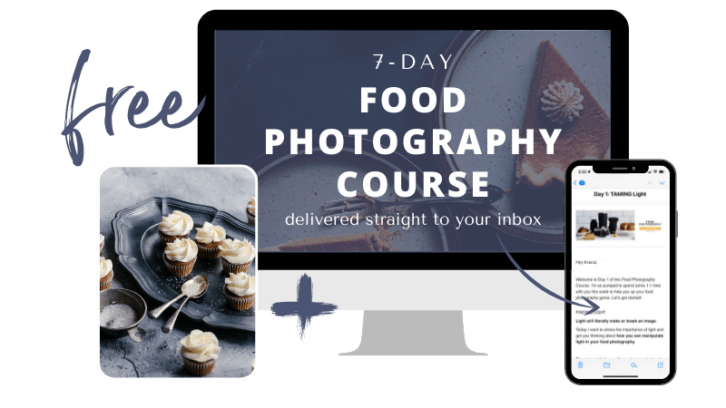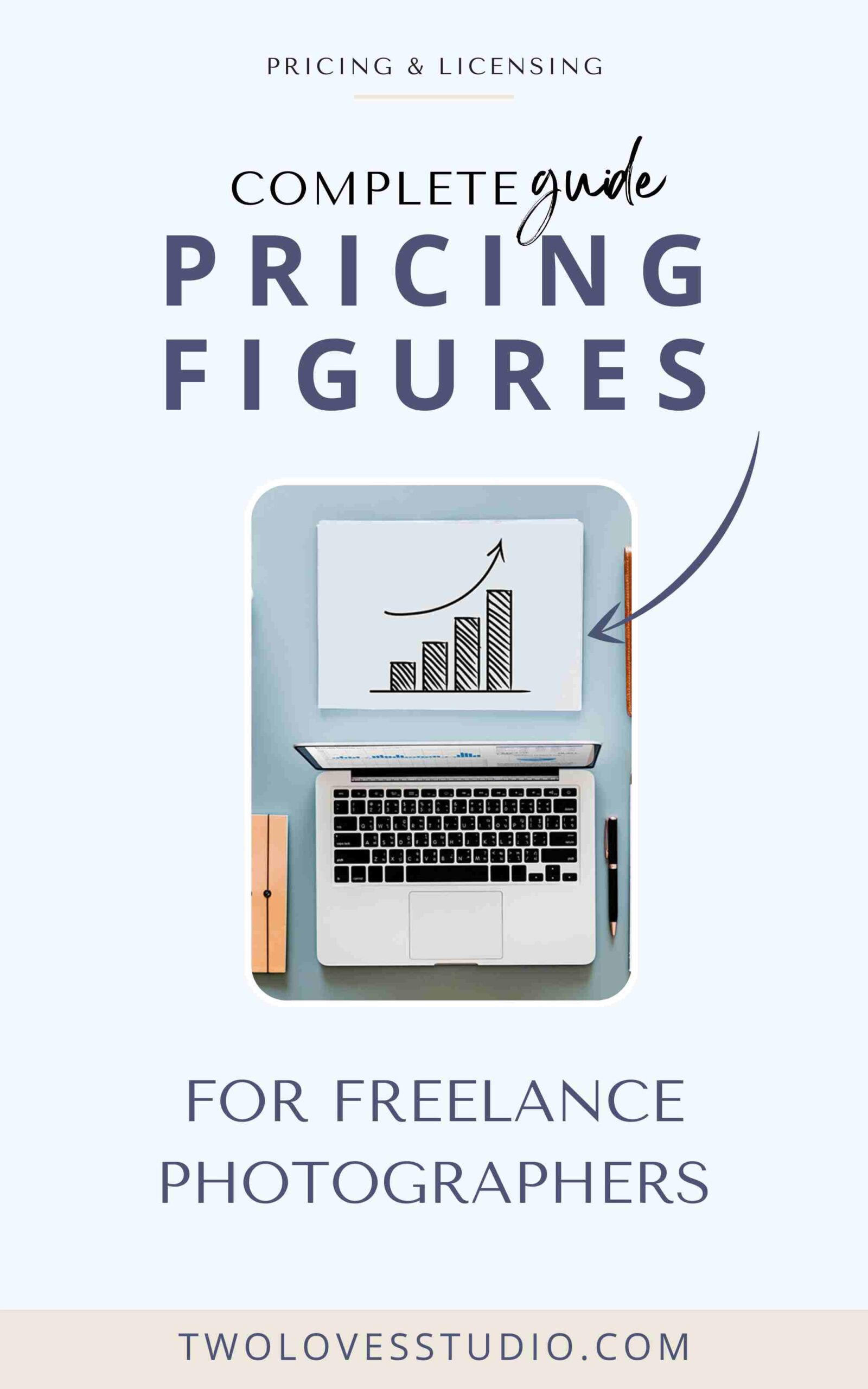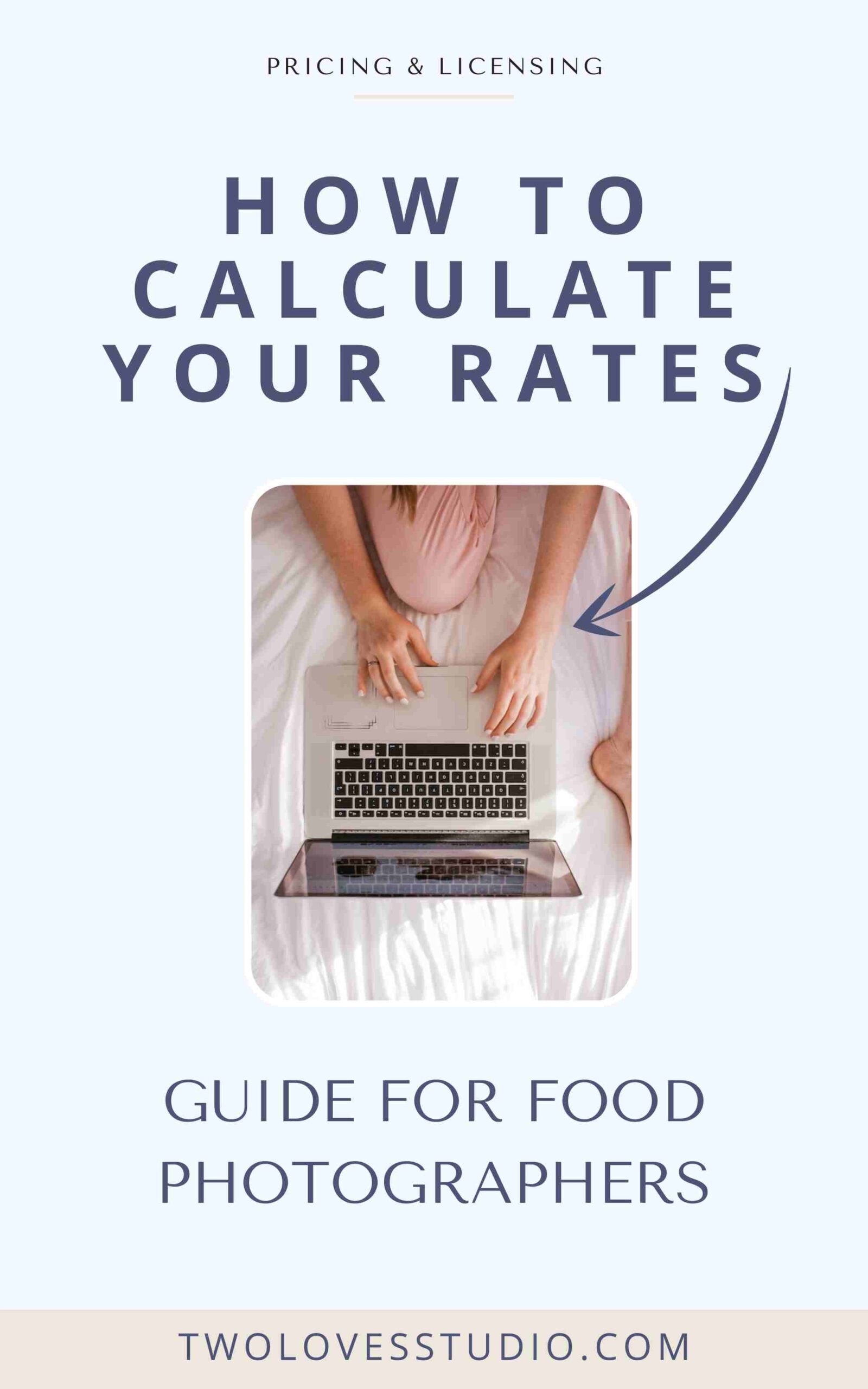This is the part that everyone wants to know! Gimme actual figures to understand how to calculate your rates as a food photography!
Most new photographers will charge per image, but there are so many methods and strategies to how you create a price list. Which one is the best will come down to the client and the job.
But first, you need to think about your costs and how much you want to earn.
This is the second part in a three-part series on food photography pricing.
Get Started Calculating Food Photography Pricing Figures
Now you’re probably not going to have the perfect figure calculated the first time around. The aim of this post is to help you learn how to calculate your rates and get you better paid than if you just pulled a figure out of thin air!
When calculating your photography pricing, we need to factor in things like:
- Amount of money you want to earn per year
- How many weeks out of a year you want to work
- Quantity of jobs per month you’d like to shoot
- Any overhead if you rent a space or hire an assistant
- How many hours it takes you to complete a job
I’m going to assume that you’re a new photographer who is working solo from home. So your overhead comes down to basic ‘home office’ expenses.
Want do You Want to Earn Per Year?
Now hopefully, you had a think about this if you came from Part 1 and come up with a figure that is reasonable and achievable for a new freelance photographer.
If you’re unsure, you could start with half of your 9-5 salary.
Or, ask yourself questions like:
- How much do I need to make to contribute to my household?
- What is the minimum I need to bring in to keep a roof over my family?
- What would help my family maintain their lifestyle and commitments?

How Many Weeks Per Year Do You Want To Work?
Kind of a weird question, but it’ll help you figure out a ballpark figure for each photography job — a great place to start.
The reason we work this out is if you want to work 8 months of the year, you’ll need to charge more to meet your salary goals, than if you worked 11 months.
This is a good question to ask because maybe you can only work part-time and you’ll lower your salary expectations. Perhaps you have the capacity to work full-time.
If you’re unsure, do with the standard working weeks for your country.
How Many Jobs Would You Like To Shoot Per Month?
This point is similar to the above. When working out how to calculate your rates, the fewer jobs we do per month, the more we need to charge. Think about your time commitment, how long it takes you to do a photo shoot (on average) and how many commissions you can take on in a month.
If you’re just starting your business, maybe 4 times a month, so once a week seems reasonable.

Now, The Figures: Food Photography Pricing Tips
The good thing about this ballpark figure is that it’s easy math.
It’s simply =
(annual salary) ÷ (working weeks ÷ 4) ÷ (jobs per month)
The trick to make this work is that you need to get the number of weeks you want to work into months. So you take weeks and divide by 4, (as there are 4 weeks in each month).
The other thing you could do is just say how many months you want to work. Don’t get too caught up on this though.
Remembering we’re after ballpark figures here.
Let’s look at an example.

Say you wanted to replace an average 9-5 job. So you go with $45,000. You want to work 48 weeks, (48 weeks ÷ 4 weeks per month = 12).
And a job a week, or 4 per month seems achievable.
Each job would, therefore, be worth $937.50. This is your starting point.
How to Calculate Your Rates: Adjust Based On Pricing Influences
Now that we have this figure, we think back to the factors that influenced food photography pricing, covered in Part 1.
Like:
- Quality
- Perceived Value
- Confidence
- Competition
We take the rate we came up with and adjust from there.
Maybe $45,000 is too much for our first year starting out. Maybe we lower that and take on one more job per month.
Now we get:

Then we take this figure and see how it ‘feels’ for us. Is it too much? Or does it feel right?
Is This a Side Hustle or Are You Working Part-time?
Maybe this exercise has you asking, is this a part-time thing, or is it currently a side hustle?
I often encourage photographers to work on their business slowly. Financial stress is known to kill creativity. If you want to start out part-time taking a few jobs here are then — that’s great!
Just remember you should be paid well for them regardless of how much time per week you spend on client work.
Perhaps you want to make $15,000:

Always assess your figures. These are starting points and don’t take into account the pricing influences we learned from Part 1 or overhead costs.
Don’t worry if this doesn’t make sense to you yet. Pricing is hard.
I have a low-cost done-for-you Pricing Calculator to help you create a pricing strategy you’ll feel confident about.
Next up, we’re going to get into some pricing tips and things to think about when creating your pricing and talking to clients about photography pricing.






Cali
This is so awesome you are amaaaaaazing! Is there a # of how many pictures you give them or is it just however many good ones you produced? Or just a couple shots?
Rachel
Hey Cali, so pleased to hear! This is such a great question. A great photographer will never give all their photos. It is part of their job to select the very best and a representation of different angles. I usually have a set number that comes with a small business package, a set number for my half/full day rates and this can also depend on if I am licensing the images for additional chargers (another whole topic one could talk for hours on!). It does depend on price too.
Shibani
Thank you so much for detailing the complex pricing factor. I am a newbie and you can understand my dilemma. This is so helpfull.
Rachel
Hey Shibani! It sure is a complex topic, so many factors to think about. I totally understand how daunting it can feel at first. Hopefully there was takeaways here you can start implementing!
davin rodriguez
Rachel this is an invaluable spreadsheet for someone just starting out! Thank you so much for taking the time to share and explain in detail!
Rachel
Hey Davin! It’s not to shabby is it? It will definitely get some solid figures for you to start thinking about. Better to be prepared for when client comes knocking, otherwise it is a little more stressful than a pleasurable experience. Thanks for stopping by!
sabrina
Rachel,
Thank you so much for taking the time in educating others about good business practices. You work is remarkable and it’s great to be taught by such an incredible and talented individual like yourself.
Sending big hugs and gratitude your way!!
Sabrina
Rachel
Oh thanks Sabrina! That is so kind of you to say. Very grateful that you found this helpful. We all need a helping hand from time to time for sure.
Joe
Hi Rachel
I have really been struggling with giving a package, or is it better to let them do a al carte.
What do most restauranteur/bar owners prefer.
I believe packages are more acceptable to weeding and grad photographers and the like.
Rachel
It can be tricky to know what each client is going to want and from experience I think it is best to work out what sort of pricing is best for your brand and will ensure you get paid for the time you put in AND make sure clients know what the cost of the job will be so there are no nasty surprises at the end.
Based on my experience it is a bit of both.
Small business clients want to know what it will cost them and what they will get. They have little experience with photographers and so I find an all inclusive package works best for them. If they want a lower price, then you remove value from that package.
For advertising clients or large magazines, they like things a little more al la carte. They expect there is a price tag to each service and will pick and choose what they need. Having said that, these are the guys that have a real strict budget (even though that budget is usually larger) they operate on more of a take it or leave it basis. So even if you have an al la carte type pricing for them, they will still come back with a budget you have to work in (mostly).
Pricing is always a journey and as you get more and more variety of clients you will learn so much and adjust your packages that it will start to get really easy for you. Every job I do has some learning curve attached.
Emma Steendam
Hi Rachel, thanks so much for this great resource! So helpful, and then I find out you’re in Melbourne – brilliant! I have been asked to do some food photography and styling for a recipe developer launching a new app/website. The work will be ongoing, needing a shoot every fortnight producing about 20 images per month for the app/website, working with the recipe developer on an ongoing basis. What are your thoughts on charging a per hourly rate but also a per image charge? They want all copyright on the images. Any advice much appreciated! Thanks, Emma
Rachel
Hey Emma! So cool to hear from you and congrats on this job. Sounds epic. You can definitely charge per the hour and per image. A lot of clients may not want a per hour rate, as they are unsure how many hours will be involved in the project. You can also quote a project fee, and say that the fee includes x amount of hours and an hourly rate will apply after that. Sort of like overtime. You can also charge per image, just be sure to really know how much time it will take you to complete the entire project. Concepting, shooting, editing, admin, travel etc. Sometimes it is of value to quote a project fee, then to break that down into a per image rate so the client can see the value in each image. The transferal of copyright is a tricky one. I personally ALWAYS strive to keep copyright. the thing you need to remember is that if you give copyright away, the client can then onsell/license your images and make money from what you shot. Leaving you with nothing. A copyright buyout is there usually very expensive and only within multi-million dollar businesses. The choice is yours however and where your values fall. Hope this helps.
Jackelin
Rachel, this is just what I was looking for. I’ve only skimmed and parts1 and 2 so far, but I can’t wait to dive in and begin filling in the worksheets. Thanks so much for making this information available. What a gift!
Rachel
You’re so welcome Jackelin, pricing can be so tough at the start. But we’ve all gotta start somewhere.
Jessica
Thank you so much Rachel for this spreadsheet! I am just beginning my business in food photography and had no idea what to do to price anything! I think my one question that I have is in terms of the calculations. If you just want to know an amount you should charge in general (without taking into account the production costs and such), would that be your fees that come out in the end without filling in the production costs field? Or do you feel those are 100% necessary to get a price average for my business?
Rachel
Hey Jessica! You can leave those production costs blank if they don’t apply to what you’re quoting or you just want to come out with a base figure. Sometimes jobs will be really simple and not require these fields, so it’s totally acceptable to not use them first up. Just be sure to keep them in mind so you’re not out of pocket in the long run 🙂
JACKELIN SLACK
Hi, Rachel! I’ve read post #1 and #2 on pricing so far, and they’ve been super helpful. Lot’s of good information here. I really appreciate the thought, time and effort you’ve put into these posts. Thank you for giving so generously of your time and for being so candid about a subject that’s so important and misunderstood.
On another note, I’m trying to access post #3 and the link seems to be broken. Any idea what might be happening?
Rachel
I will take a look into why the link isn’t working 🙂 Thanks for letting me know Jackelin and glad you found it useful!
JACKELIN SLACK
BTW, Rachel, I was able to access post #3, I think from another link. Thank you!
JACKELIN SLACK
Hi, Rachel! The Pricing Worksheet has been super helpful! Would you be able to clarify one thing for me, please? What is the difference between the preliminary fees and the final fees? I understand that the preliminary fees is what I’m charging the client right? So what is the other?
Rachel
Great question! So after you come up with your preliminary fees, you’ll want to think about all those factors we talked about in the two prior posts, like confidence level, sense of value the client will have for your style, the time it takes you to shoot. So you can think if you want to adjust up or down to your comfort level. Does that make more sense 🙂
JACKELIN SLACK
I see! Well, I have to tell you this has been so valuable to me over the past several weeks. As a portrait photographer, I didn’t give very careful consideration to my fees – I mostly flew by the seat of my pants. That is not to say it was working for me to price my work the way I did. Your advice and your worksheets have really made me think seriously about the financial value of the work I do. I can’t believe I’ve been doing this for so long without real consideration of these factors you outline. Thank you, thank you, thank you for your generosity in making these resources available. Sending you a warm hug across the ocean (and I hope to meet you at the Everything Food Conference if you’ll be there in May).
Rachel
That really makes my day! We don’t always know these things when we start out right, and we all take different paths. Maybe the time is right for you know and you’ll have more confidence! So cool you be at EFBC! Be sure to stop by to say hi or come to my talk! xx
Beth
Hi Rachel! I tried to click on the download link for the Free Pricing Spreadsheet, and all that pops up is an option to join your e-mail list, which I did. But I didn’t see where I could download the spreadsheet. Can you direct me where to find it? Thank you so much for all your time that went into it – I can’t wait to use it! xox
Rachel
Awesome Beth! When you sign up you’ll get an email with a link and password where you can access the Resource Hub!
Roberta Dall'Alba
Hi Rachel!
Just a question: is it “(annual salary) ÷ (working weeks ÷ 12) ÷ (jobs per month)” or “(annual salary) ÷ (working weeks ÷ 4) ÷ (jobs per month)”?
x
Roberta
Rachel
Yes! We are trying to get the weeks we want to work in back into months (for the way this calculation works) so we do want to divide by 4 in order to make it into months (as there are 4 weeks in a month). I’ll make sure to update the graphic. Thanks so much.
Kelly
Except, as a freelancer, you don’t get to keep all of that. Set aside 25 – 30% for taxes. Otherwise, at the end of the year Uncle Sam will be sticking you with an unplanned tax bill.
Rachel Korinek
That is certainly true Kelly! If you make enough to pay taxes, then for sure you’ll need to keep aside tax at the tax rate set by your country for your income level. Having a surprise bill at the end is no fun right?